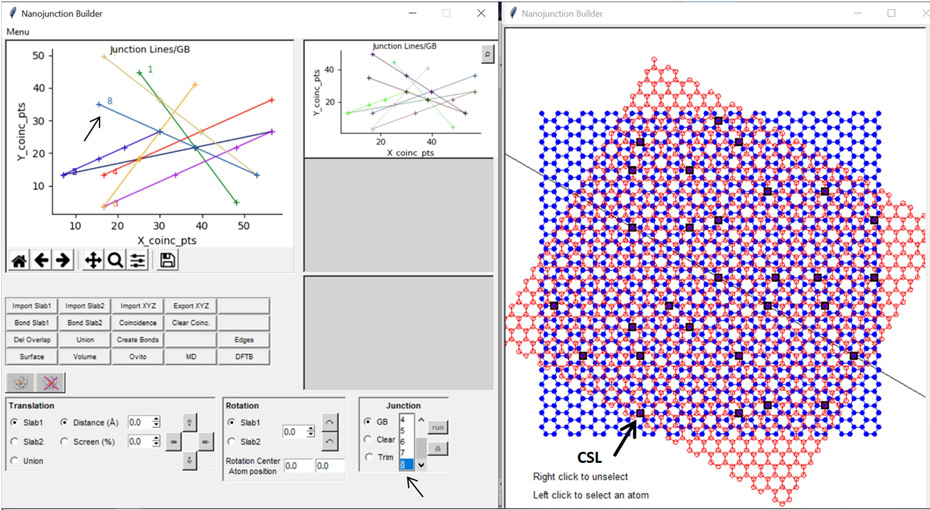- Details
- Last Updated: Friday, 30 December 2022 15:09
Nano-Junction Builder (nJB), a Computer Tool for Building and Studying Junctions of 1D and 2D Nanomaterials
There is a strong need for computer tools that facilitate manufacturing of known nanomaterials, enable creating new ones, and construct nanojunctions, such as the hard to make 1D and 2D structures, and nanodevices involving 2D-2D materials (e.g., graphene, silicene, or combined heterostructures), 1D-1D materials (e.g., molecular chains, CNT-CNT) and 1D-2D junctions (e.g., CNT-graphene). Designing nanoscale junction or predicting its properties requires an extra design effort of atomistic systems and matching the lattice points for the joined material lumps. This project focuses on developing and integrating computer tools for prototyping nanosheet and nanotube junctions to name a few. The developed tool is called nano-Junction Builder (nJB).
.
Material systems such as carbon nanotubes (CNTs), boron-nitride nanotubes (BN-NTs), Graphene, Silicene, 2D Janus, and Graphene oxide stacks can be laterally joined to form an active device or stacked. These and other new materials are extremely important as they seem to become the core of next generation electronics and quantum devices; devices made of these materials can be further studied using the nJB.
A suite of interconnected tools has been developed to permit construction nanojunctions between nanomaterials of mixed dimensions. The nJB software package was designed by Karoui and Sahtout and coded in python by Sahtout. The software is designed to connect with open-source atomistic software such as the Large-scale Atomic/Molecular Massively Parallel Simulator (LAMMPS)[i], DFTB software and the semi-empirical atomistic calculations software Molecular Orbital Package (MOPAC)[ii], a popular semi-empirical quantum chemistry software.
The tools within the nJB software allow junction of nanomaterial fragment of the same type with various specifications (size of fragments, orientation, chirality in case of CNTs,…) or making heterojunctions between two fragments of different materials. Homojunctions are built from the same 2D nanomaterials, for instance graphene. The junction could be with either a narrow or wide-angle misorientation. The angle implies different bonding strategies at the boundary and results in different kinds of disorders in the junction region.
The “as built” junction zone (JZ) of the new structure is initially under large stress. The tool allows various relaxations of the prototype. The atomic system is brought close to its ground state via a sequence of geometry optimization phases. By analyzing the coincidence lattice, the junction is brought close to its ground state by doing a crystallography based matching of the two fragments (or molecules). In the case of graphene slabs the 2D lattices are coplanar with the coincidence lattice. The calculated strain guides the user for finely adjusting the relative positions of the sheets, with the guiding criterion being minimizing the strain. Unlike the MD energy minimization process which changes the atom position with certain mathematical process such as shake and rattle, maximizing the coincidence lattice is crystallography based. It allows to minimize the surface (or line) energy by maximizing the contact surface at the junction.
|
Screen copy of the nJB GUI and the atomic structure Visualizer. This shows two graphene sheets being prepared for generating a tilt-junction between two graphene sheets. The black squares are the coincidence points; The line is #8 selected junction line. |
In a second stage further relaxation is made through the classical molecular dynamics. Precautions are made such the whole process makes the lattice matching dominates the junction construction, and that MD brings a second order variations of the atom positions.
This software also allows the building and analysis of extended defects in particular grain boundaries (GB): twin boundaries, as well as small, large angle and general GB. These are viewed exactly like an active electronic crystalline junction.
The nJB is the product of a Faculty Fellowship received by Dr Karoui from the nanoMFG, an NSF sponsored center. The end users are students and scientists from the materials science and physics communities in the field. The software was intended to be an open source that will hopefully prompt new research projects, both theoretical and experimental. Daren in Dr Elif Ertkin’s research team is thanked for collaborating and sharing computation resources.
[i] LAMMPS: Large-scale Atomic/Molecular Massively Parallel Simulator, a molecular dynamics package developed by Sandia National Laboratories. https://lammps.sandia.gov/
[ii] MOPAC (Molecular Orbital PACkage) is a semiempirical quantum chemistry program based on Dewar and Thiel's NDDO approximation. http://openmopac.net/

